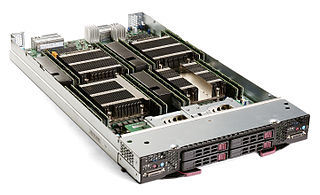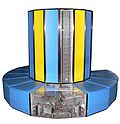
A supercomputer is a computer with a high level of performance as compared to a general-purpose computer. The performance of a supercomputer is commonly measured in floating-point operations per second (FLOPS) instead of million instructions per second (MIPS). Since 2017, there are supercomputers which can perform over a hundred quadrillion FLOPS (petaFLOPS). Since November 2017, all of the world's fastest 500 supercomputers run Linux-based operating systems. Additional research is being conducted in China, the United States, the European Union, Taiwan and Japan to build even faster, more powerful and technologically superior exascale supercomputers.
Cray Inc., a subsidiary of Hewlett Packard Enterprise, is an American supercomputer manufacturer headquartered in Seattle, Washington. It also manufactures systems for data storage and analytics. Several Cray supercomputer systems are listed in the TOP500, which ranks the most powerful supercomputers in the world.

Quadrics was a supercomputer company formed in 1996 as a joint venture between Alenia Spazio and the technical team from Meiko Scientific. They produced hardware and software for clustering commodity computer systems into massively parallel systems. Their highpoint was in June 2003 when six out of the ten fastest supercomputers in the world were based on Quadrics' interconnect. They officially closed on June 29, 2009.

Altix is a line of server computers and supercomputers produced by Silicon Graphics, based on Intel processors. It succeeded the MIPS/IRIX-based Origin 3000 servers.
EPCC, formerly the Edinburgh Parallel Computing Centre, is a supercomputing centre based at the University of Edinburgh. Since its foundation in 1990, its stated mission has been to accelerate the effective exploitation of novel computing throughout industry, academia and commerce.
The Texas Advanced Computing Center (TACC) at the University of Texas at Austin, United States, is an advanced computing research center that provides comprehensive advanced computing resources and support services to researchers in Texas and across the USA. The mission of TACC is to enable discoveries that advance science and society through the application of advanced computing technologies. Specializing in high performance computing, scientific visualization, data analysis & storage systems, software, research & development and portal interfaces, TACC deploys and operates advanced computational infrastructure to enable computational research activities of faculty, staff, and students of UT Austin. TACC also provides consulting, technical documentation, and training to support researchers who use these resources. TACC staff members conduct research and development in applications and algorithms, computing systems design/architecture, and programming tools and environments.
The Cray CX1 is a deskside high-performance workstation designed by Cray Inc., based on the x86-64 processor architecture. It was launched on September 16, 2008, and was discontinued in early 2012. It comprises a single chassis blade server design that supports a maximum of eight modular single-width blades, giving up to 96 processor cores. Computational load can be run independently on each blade and/or combined using clustering techniques.
PERCS is IBM's answer to DARPA's High Productivity Computing Systems (HPCS) initiative. The program resulted in commercial development and deployment of the Power 775, a supercomputer design with extremely high performance ratios in fabric and memory bandwidth, as well as very high performance density and power efficiency.

Jaguar or OLCF-2 was a petascale supercomputer built by Cray at Oak Ridge National Laboratory (ORNL) in Oak Ridge, Tennessee. The massively parallel Jaguar had a peak performance of just over 1,750 teraFLOPS. It had 224,256 x86-based AMD Opteron processor cores, and operated with a version of Linux called the Cray Linux Environment. Jaguar was a Cray XT5 system, a development from the Cray XT4 supercomputer.
Tianhe-I, Tianhe-1, or TH-1 is a supercomputer capable of an Rmax of 2.5 petaFLOPS. Located at the National Supercomputing Center of Tianjin, China, it was the fastest computer in the world from October 2010 to June 2011 and is one of the few petascale supercomputers in the world.
The Cray XT6 is an updated version of the Cray XT5 supercomputer, launched on 16 November 2009. The dual- or quad-core AMD Opteron 2000-series processors of the XT5 are replaced in the XT6 with eight- or 12-core Opteron 6100 processors, giving up to 2,304 cores per cabinet. The XT6 includes the same SeaStar2+ interconnect router as the XT5, which is used to provide a 3-dimensional torus network topology between nodes. Each XT6 node has two processor sockets, one SeaStar2+ router and either 32 or 64 GB of DDR3 SDRAM memory. Four nodes form one X6 compute blade.

The Cray XE6 made by Cray is an enhanced version of the Cray XT6 supercomputer, officially announced on 25 May 2010. The XE6 uses the same computer blade found in the XT6, with eight- or 12-core Opteron 6100 processors giving up to 3,072 cores per cabinet, but replaces the SeaStar2+ interconnect router used in the Cray XT5 and XT6 with the faster and more scalable Gemini router ASIC. This is used to provide a 3-dimensional torus network topology between nodes. Each XE6 node has two processor sockets and either 32 or 64 GB of DDR3 SDRAM memory. Two nodes share one Gemini router ASIC.

The Minnesota Supercomputing Institute (MSI) in Minneapolis, Minnesota is a core research facility of the University of Minnesota that provides hardware and software resources, as well as technical user support, to faculty and researchers at the University and at other institutions of higher education in Minnesota. MSI is located in Walter Library, on the University of Minnesota’s Twin Cities campus.
India's Supercomputer Programme was started in late 1980s, precisely during the 3rd quarter of 1987, in New Delhi for Software, in Bangalore for Hardware, and in Pune for Firmware, while Sam Pitroda, Advisor to C-DOT, and C-DOT's Indigenous Architecture and Design Team constituted by its Senior Member Technical Staff / Senior Programme Managers including Mohan Subramaniyam alias Mohan Rose Ali, Periasamy Muthiah, and Leslie D'Souza had all worked hard at the Centre for Development of Telematics (C-DOT), after successfully completing their 3 years mission on designing the Nation's first ever indigenous C-DOT Digital Switching System - DSS, to create C-DOT's Indigenous Super-computing Machine called CHIPPS - C-DOT High-Performance Parallel Processing System, because the contracted Cray X-MP Supercomputers were denied for export to India which was under the Statesmanship and Stewardship of Mr. Rajiv Gandhi, the then Prime Minister of India, due to an arms embargo imposed by US on India during Ronald Reagan's Presidential Administration, for it was a dual-use technology and it could be used for developing indigenous Strategic Defense Systems by India.

Several centers for supercomputing exist across Europe, and distributed access to them is coordinated by European initiatives to facilitate high-performance computing. One such initiative, the HPC Europa project, fits within the Distributed European Infrastructure for Supercomputing Applications (DEISA), which was formed in 2002 as a consortium of eleven supercomputing centers from seven European countries. Operating within the CORDIS framework, HPC Europa aims to provide access to supercomputers across Europe.
The Cray XK6 made by Cray is an enhanced version of the Cray XE6 supercomputer, announced in May 2011. The XK6 uses the same "blade" architecture of the XE6, with each XK6 blade comprising four compute "nodes". Each node consists of a 16-core AMD Opteron 6200 processor with 16 or 32 GB of DDR3 RAM and an Nvidia Tesla X2090 GPGPU with 6 GB of GDDR5 RAM, the two connected via PCI Express 2.0. Two Gemini router ASICs are shared between the nodes on a blade, providing a 3-dimensional torus network topology between nodes. This means that it has 576 GB of Graphics memory and over 1500 CPU cores, several orders of magnitude more powerful than the best publicly available computer on the market.

Approaches to supercomputer architecture have taken dramatic turns since the earliest systems were introduced in the 1960s. Early supercomputer architectures pioneered by Seymour Cray relied on compact innovative designs and local parallelism to achieve superior computational peak performance. However, in time the demand for increased computational power ushered in the age of massively parallel systems.

Titan or OLCF-3 was a supercomputer built by Cray at Oak Ridge National Laboratory for use in a variety of science projects. Titan was an upgrade of Jaguar, a previous supercomputer at Oak Ridge, that uses graphics processing units (GPUs) in addition to conventional central processing units (CPUs). Titan was the first such hybrid to perform over 10 petaFLOPS. The upgrade began in October 2011, commenced stability testing in October 2012 and it became available to researchers in early 2013. The initial cost of the upgrade was US$60 million, funded primarily by the United States Department of Energy.

Appro was a developer of supercomputing supporting High Performance Computing (HPC) markets focused on medium- to large-scale deployments. Appro was based in Milpitas, California with a computing center in Houston, Texas, and a manufacturing and support subsidiary in South Korea and Japan.

XK7 is a supercomputing platform, produced by Cray, launched on October 29, 2012. XK7 is the second platform from Cray to use a combination of central processing units ("CPUs") and graphical processing units ("GPUs") for computing; the hybrid architecture requires a different approach to programming to that of CPU-only supercomputers. Laboratories that host XK7 machines host workshops to train researchers in the new programming languages needed for XK7 machines. The platform is used in Titan, the world's second fastest supercomputer in the November 2013 list as ranked by the TOP500 organization. Other customers include the Swiss National Supercomputing Centre which has a 272 node machine and Blue Waters has a machine that has Cray XE6 and XK7 nodes that performs at approximately 1 petaFLOPS (1015 floating-point operations per second).















